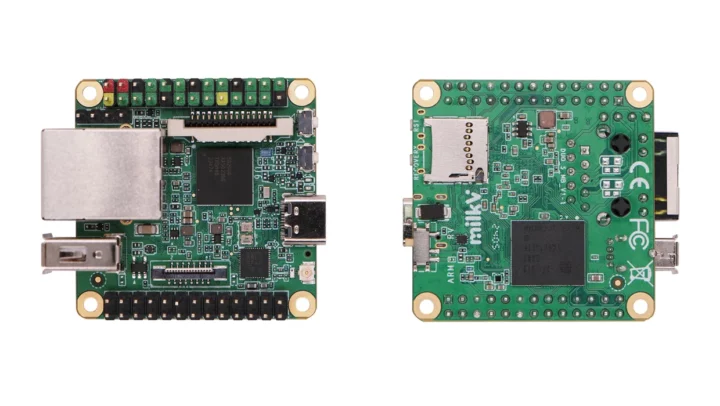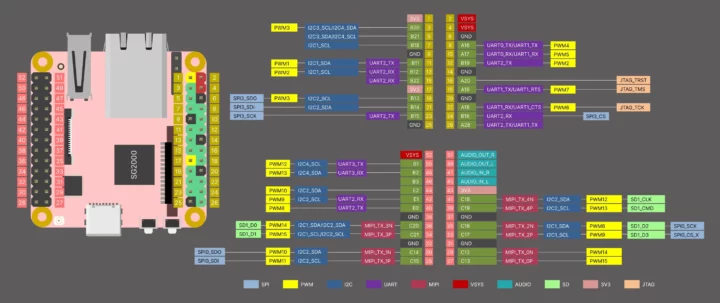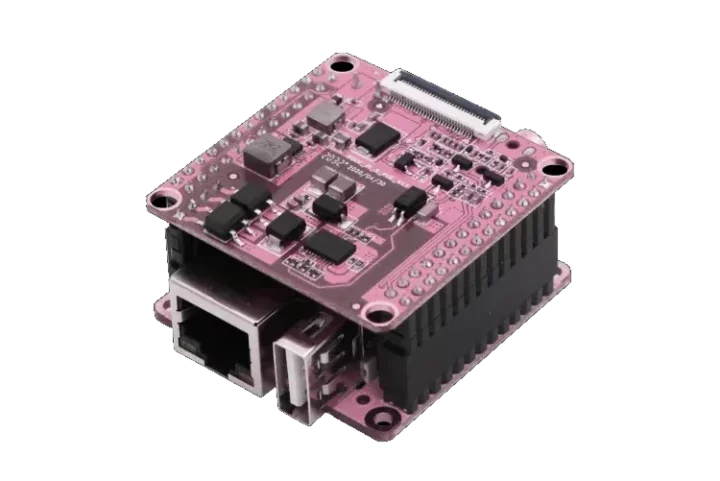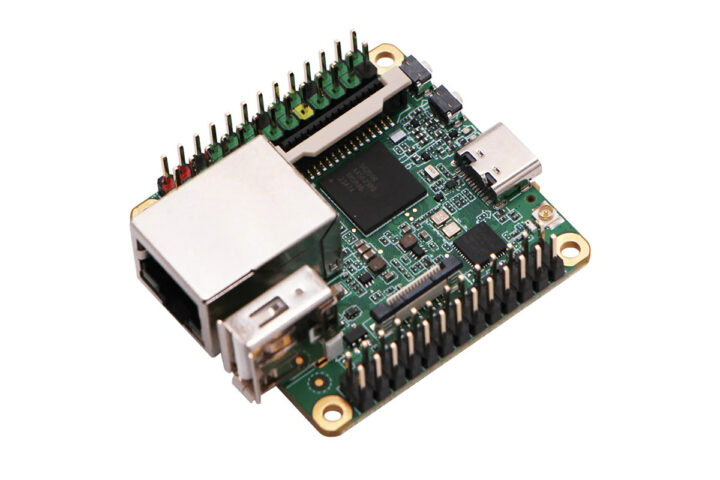Shenzhen MilkV Technology’s Duo S is a tiny SBC based on the 1 GHz Sophgo SG2000 Arm Cortex-A53 and RISC-V SoC with 512MB DDR3 (SiP), Fast Ethernet, WiFi 6, and Bluetooth 5 connectivity, and a switch to select Arm or RISC-V architecture before powering the board.
We already had covered SG2002 Arm/RISC-V boards with 256MB RAM, namely the LicheeRV Nano and Duo 256M, but for people needing more memory, the Duo S provides another option that also features two 2-lane MIPI CSI connectors, a USB 2.0 host port, and two 26-pin headers for expansion. Its form factor reminds me of FriendlyELEC’s NanoPi NEO and family powered by Allwinner processors that were introduced a few years ago.
Duo S specifications:
- SoC – SOPHGO SG2000
- Main core – 1 GHz 64-bit RISC-V C906 or Arm Cortex-A53 core (selectable)
- Minor core – 700 MHz 64-bit RISC-V C906 core
- Low-power core – 25 to 300 MHz 8051 MCU core with 8KB SRAM
- NPU – 0.5 TOPS INT8, supports BF16
- Integrated 512MB DDR3 (SiP)
- Storage
- MicroSD card slot
- Optional 8GB eMMC flash
- Display – 4-lane MIPI DSI via GPIO header
- Camera Interfaces
- 16-pin FPC connector for 2-lane MIPI CSI
- 15-pin FPC connector for 2-lane MIPI CSI
- Support for 5MP camera sensors
- Audio – Built-in microphone
- Networking
- 100Mbps Ethernet RJ45 jack with optional PoE support via expansion board
- Optional WiFi 6 and Bluetooth 5
- USB – 1x USB Type-C port for power and programming, 1x USB 2.0 host port (Note: USB-C and USB 2.0 ports are multiplexed, so only one can be used at a time)
- Expansion – 2x 26-pin 2.54 pitch headers with access to up to 39x GPIO, PWM, I2C, SPI, UART, MIPI DSI, JTAG, SD, Audio, power signals
- Debugging – 4-pin UART header
- Misc – BOOT Switch (Arm vs RISC-V selection), Recovery Key, Reset Key
- Power Supply – 5V via USB-C port
- Dimensions – 43 x 43mm
 Linux and RTOS are said to be supported on the Duo S, and you’ll find buildroot-built OS images on GitHub to boot from either the microSD card or the eMMC flash. As of the current v1.0.9 image, Duo S does not yet support wiringX (C) and pinpong (Python) GPIO libraries, and Arduino support is not implemented either. The latter means the board will eventually be programmable like a microcontroller using the Arduino IDE as is already possible on the Duo 256M with SG2002. Some instructions to get started can be found in the wiki.
Linux and RTOS are said to be supported on the Duo S, and you’ll find buildroot-built OS images on GitHub to boot from either the microSD card or the eMMC flash. As of the current v1.0.9 image, Duo S does not yet support wiringX (C) and pinpong (Python) GPIO libraries, and Arduino support is not implemented either. The latter means the board will eventually be programmable like a microcontroller using the Arduino IDE as is already possible on the Duo 256M with SG2002. Some instructions to get started can be found in the wiki.

The Duo S SBC can be purchased for $9.99 to $18.99 on Arace depending on the options such as WiFi 6 and Bluetooth 5 module, 8GB eMMC flash module, PoE support, etc… It can also be bought on Aliexpress for $16 and up. More details may be found on the product page.


Jean-Luc started CNX Software in 2010 as a part-time endeavor, before quitting his job as a software engineering manager, and starting to write daily news, and reviews full time later in 2011.
Support CNX Software! Donate via cryptocurrencies, become a Patron on Patreon, or purchase goods on Amazon or Aliexpress. We also use affiliate links in articles to earn commissions if you make a purchase after clicking on those links.






The board indeed looks appealing, but the SDK is still in a pathetic state with a 5.10.4 kernel that misses something like 25000 fixes. This is simply irresponsible and not acceptable. It shows the vendor has not understood anything to what software development and maintenance means nor how Linux works. And that’s quite scary to imagine that the same vendor is now making devices that will have WiFi connectivity.
Thanks for the suggestions, Willy. The SG200x upstream work is WiP, you can find the status here:
https://github.com/sophgo/linux/wiki
Our long term plan is to have everything upstreamed, including the TPU. TPU design will be open sourced also in the future.
Willy’s comments are reflective of many consumers of products like this.
Mainstream support offers substantial benefits for both the customer and the supplier. The customer benefits from an actively maintained (not just new features, but *security* fixes) kernel. The supplier benefits by allowing them to offer a much more attractive software product with much lower maintenance cost.
What Willy and others need vendors to do is to push back upstream to the chip suppliers and make them aware that their old SDKs are not very helpful and that they should focus their efforts on releasing mainstream support from the beginning. Software support for chips shouldn’t be an afterthought, it sould be incorporated into the chip design and its cost considered as part of the product.
Producing some silicon and throwing it to some other group and saying “now ship it” is not an effective development model.
The only ones who can tell the silicon manufacturers this is vendors who make products with their devices and support end customers. But it’s up to us end customers to let the vendor know this is important to us.
I have 8 Milky-V DUO boards and I’m very happy with the design of the product. I am also very interested in this product and I agree with Willy that mainline support is an important feature that customers want.
Yep that’s it. Actually I’m not even an extremist like those who say everything must work in mainline at the tape-out. I mean, having a patchset to rebase on top of an LTS branch it often quite acceptable. It even forces developers to think a little bit about how to best integrate their stuff to limit conflicts thus interactions with other parts. But here that’s not the case, the SDK was never updated at all and it’s distributed as *the* kernel. The current 5.10.x branch is 5.10.213. If the kernel in the SDK was 5.10.180 or so, one could think “OK it’s not the freshest, let’s just rebase it”. But at 5.10.4 you understand it will never even work because if nobody took the time to occasionally rebase it, it’s just because it was hacked in force the dirty way and just cannot be rebased. *this* is a big problem.
In honor of the manufacturer I will say that the wiki page describing mainlining process and the fact that the patches are ready and on review is a much better state than almost any other Chinese manufacturer out there.
Yes definitely!
Agreed.
Is there any extra specs on “WiFi 6 and Bluetooth 5” ?
Like, is it 5GHz?
WiFi 6 must support all those bands, so yes. And I’ve seen it connect to 5 GHz.
The board consumes very little power. Iperf3 saturates the wired connection (>90 Mbits) but WiFi is faster, especially on 5 GHz (>180 Mbits). Internal iperf3 (sending to itself via loopback) is about 650 Mbits. Hoping for a review here!
Nice!
Will Armbian run on it?
Last time I checked the Milk boards they didn’t support Linux suspend (to ram/disk) – boards just consume all the power. Any progress now ?
This feature is work in progress, expected to have it by the end of April.
Does onboard Wi-Fi/Bluetooth need external antenna? I could not find neither PCB antenna nor the connector for the external one on the photos.
Found the connector on the board, near USB-C.
Sure looks like an exact copy of the Rock Pi S, down to the button, connector positions, headers, and PoE connection, etc…
Both companies seem to be related although they are different entities. I sometimes get news about Milk-V hardware through Radxa.